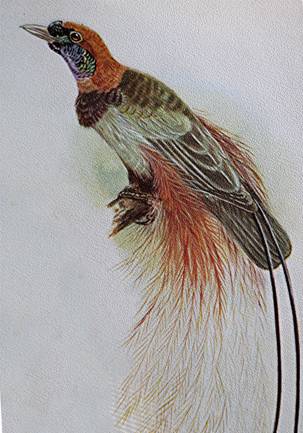Blood’s Bird of Paradise was named for N.B.
Blood. Neptune (‘Ned’) Beresford Blood was on active service
in WW2 when he first saw the Wahgi Valley in New Guinea’s central
highlands. Staying on in NG, he gave Edward Hallstrom the idea for a
pioneering sheep-raising project which was established at Nondugl in the Wahgi
Valley, together with a small zoological collection. Blood was the first
manager of the station, collecting wildlife, including live specimens of birds
of paradise. Later the station was transferred to the
Administration and eventually closed, with the BoP collection being transferred
to Baiyer River, still a good place to see these birds if you visit the PNG
highlands. There is more about the Wahgi Valley and the Nondugl of those days
in Colin Simpson’s book Adam in Plumes 1954.
Blood sent a large number of specimens to the Australian
Museum, where they so excited Tom Iredale that he decided to write a book on
the subject, Birds of Paradise and Bower Birds (1950). In this he records
the new species Paradisea bloodi. Iredale mentions the possibility
that this was a hybrid between a Blue and the red-plumed raggiana, but
rejects that possibility on ground of distribution of those species. He
says of the single specimen ‘this bird must be seen to be admired and
understood’. Here is Lilian Medland’s drawing (omitting the
full streamers) :

Iredale’s museumy book, like his other 2 volumes on
New Guinea birds, can reasonably be criticised on several grounds.
However there were precious few references on NG birds at that time.
Furthermore, birds of paradise, apart perhaps from the ‘common’
one, were hard to come across, and a kind of substitute was being able to
goggle at the generous number of species (some 80!) pictured in the book.
In the early 1960s I spent some weeks in Madang, staying at
the Madang Hotel. Ned Blood, then based there with the Department of
Agriculture, Stock and Fisheries, used to drink at what might be loosely called
the public bar, a hose-downable Quonset-hut annexure to the main
hostelry. On the subject of his BBoP, he was inclined himself to doubt
the validity of the species. However he pointed out to me a Thomas
Gilliard, an American ornithologist also staying at the pub who was an authority
on NG birds. This was of some interest to me as Gilliard had authored Living
Birds of the World, one of the first of what has become a stream of popular
surveys of world bird families. He was working on a handbook of New
Guinea birds. (He collected birds in the Port Moresby hinterland
just after WW2, and was, I later found, responsible for the evocative bird
diorama in the American Museum of Natural History depicting the Rouna Falls
area, near the start of the Kokoda Track - worth a look when you’re
in New York, if it’s still there.)
Gilliard had no doubt that bloodi was a hybrid.
I remember his telling me that hybridisation in BoPs was not unusual, one
reason being that species were very specific to particular altitudes, and
population pressures in the highlands (there had been a people explosion since
pre-European introduction of the sweet potato) had caused clearing of great
zones of forest. This had forced remnants of species in the cleared zones
up or down into the domain of other species.
In his own Birds of Paradise and Bower Birds,
published in 1969 after his death, Gilliard lists 18 named hybrids, one being Paradisea
bloodi, given as a cross between the Blue and raggiana.
With its omission from recent books on New Guinea birds, Blood’s Bird of
Paradise has all but faded from current memories.

